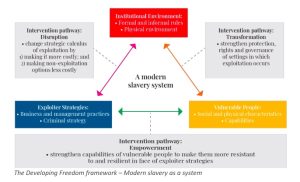
Developing Freedom: The Sustainable Development Case for Ending Modern Slavery
This blog post is part of our effort to support the goals of SDG Target 8.7, which saw 193 countries pledge their commitment to take effective measures to eradicate modern slavery, human trafficking, and forced and child labour. Towards that we are sharing work under Delta 8.7—part of the SDG Target 8.7 that aims to help policy actors understand and use data responsibly to inform policies that contribute to achieving Target 8.7.
James Cockayne, NSW Anti-slavery Commissioner writing for the United Nations University Center for Policy Research
How can fighting slavery contribute to sustainable development?
This is the question addressed in a new study from UN University Centre for Policy Research, Developing Freedom.
The study was commissioned by the UK Government and undertaken over almost two years by an interdisciplinary research team I led, including Dr Kelly Gleason, Angharad Smith, Nesrien Hamid, Otilia Enica and Julie Oppermann, with inputs from Professor Caf Dowlah, and researchers at the University of Nottingham Rights Lab, The Purpose Business and Partnership for International Development. It involved comprehensive literature reviews, quantitative
analysis, surveys and mixed methods case studies of six global value chains: apparel, cattle, construction, cotton, fisheries and palm oil.
Limited spending
Ending modern slavery is one aspect of Target 8.7 of the UN Sustainable Development Goals. The study identifies connections between anti-slavery efforts and 113 of the 179 SDG Targets but found limited engagement by development actors with anti-slavery objectives.
First, we analysed more than 2 million official aid project records from 2000 to 2017. On average, less than USD 12 per victim was committed in aggregate ODA, globally, each year. Most commitments are small (median = USD 109,000 for bilateral projects, USD 18,000 for multilaterals). ODA spending was spread increasingly thinly over time.
The US was the leading development donor focused on anti-slavery objectives. It contributed around 43 per cent of aggregate ODA, four times the EU commitment, and 7 times that of Norway, Germany, Canada, Australia, Spain, Sweden, UK and Switzerland. Most spending has been in Asia-Pacific, followed by Africa. Spending was not based on need alone but also varied by type of exploitation. Spending on forced labour and human trafficking outpaced that on forced marriage, modern slavery and child soldiering.
A narrow take on anti-slavery
Next, we surveyed practitioners from 16 countries and reviewed practice from bilateral development agencies (US, UK, Norway, Australia), multilateral development banks (the World Bank, ADB, AfDB, EBRD, EIB, IDB), export credit agencies, development finance institutions, new lenders (AIIB, New Development Bank), and China. 67 per cent of respondents said their organization saw slavery as a social or criminal justice policy concern, not as an economic, trade or industrial policy concern. Only 21 per cent said that slavery reduction is an objective of investment and lending decisions.Slavery reduction is treated as a project safeguarding question, not an objective of spending, lending and advice. There are growing efforts from the OECD, IFC and others to promote responsible business conduct (RBC) by beneficiaries. But these efforts may not reach the upstream, informal sites of slavery, or address the intersection of programming with contextual factors in ways that increase risk.
A siloed approach at the UN
The formal UN Development System architecture has also had limited engagement with these issues. We reviewed 396 UN country-level development frameworks (2000-present). Most references to SDG 8.7 exploitation were contextual or to a single UN entity’s programming. Only 1.3 per cent of the time was reduction of these risks treated as a strategic development opportunity warranting joint programming, with most of such references being before 2005. Most work is criminal justice-oriented, led by UNODC, or labour policy-oriented, led by ILO. Since there is no UN operational entity addressing ‘modern slavery’ or ‘slavery’, such programming is rare. There is a risk of anti-slavery efforts becoming disconnected from broader UN development system assistance at the country-level.
The costs of denying economic agency
One reason for this separation between anti-slavery work and development discourse and practice may be analytical. The study finds that existing approaches to development, including the human development approach inspired by Amartya Sen, focus on developing people’s capabilities. They assume that people have basic economic agency, for example the ability to leave a job they do not like or to control their own consumption, savings and investment choices. Slavery disrupts that assumption. It requires a different response that protects and maximizes agency.
The agency theft that slavery represents ripples through the economy, snowballing into large scale, intergenerational effects that create major impediments to sustainable development, and leave everyone worse off.
Drawing on extensive literature reviews, the study identifies 10 ways in which slavery impedes development:
- Slavery reduces productivity.
- Slavery creates inter-generational poverty.
- Slavery institutionalizes inequality.
- Slavery weakens multiplier effects.
- Slavery discourages innovation in production.
- Slavery produces a capital market failure.
- Slavery hits the public purse.
- Slavery weakens governance.
- Slavery fuels corruption and illicit financial flows.
- Slavery harms the environment.
Seeing these impact vectors in combination leads to a conclusion that slavery systems work as rentier systems. A slavery system represents a stable, but dynamic, equilibrium between three forces: 1) an institutional environment, that interacts with 2) vulnerable people in a way that allows the emergence of profitable 3) exploiter strategies. Development interventions can, consequently, work to break the connections between these factors in one of three ways: by transforming how the institutional environment generates (or reduces) vulnerability; by empowering people to make them more resistant to exploiter strategies; or by disrupting the strategy in ways that make it less profitable, whether by increasing the costs or by lowering the cost of alternative strategies.
Disrupting slavery systems in global value chains
The study uses this framework to analyze anti-slavery efforts by development actors in six different global value chains: apparel, cattle, construction, cotton, fisheries and palm oil. It considers efforts in Bangladesh, Brazil, Ethiopia, India, Indonesia, Malaysia, Myanmar, Nigeria, Philippines, Qatar, Thailand, UK and Uzbekistan. The study finds evidence of significant positive impacts on slavery prevalence in several cases, especially where diverse actors have coordinated know-how, political capital and resources through a shared intervention strategy.
The rents that slavery systems generate are lucrative and frequently protected by powerful political interests, so anti-slavery interventions from outside the system frequently meet active resistance, sometimes even involving violence. The rentiers that control the slavery system work to protect and maintain their autonomous domain. One key conclusion in the study is the need to recognize the political nature of interventions to address slavery systems.
An Agenda for Developing Freedom
The study also explores the opportunities created by pandemic response to disrupt the slavery systems embedded in some global value chains. It identifies opportunities arising both out of the convergence of sustainable development and ESG investing – with a stronger alignment around positive social impacts; and out of the increased ownership and management role in private sector companies that governments have assumed in response to the pandemic.
The study looks to the historical case of the financialized development of the Mississippi Valley in the 1830s for insights about some of the risks involved in collateralized lending to projects connected to slavery and forced labour risks. And from this emerges a series of recommendations described as an ‘Agenda for Development Freedom’. This includes recommendations to development actors to:
Commit to develop freedom: make maximizing economic agency a development goal, alongside economic growth and poverty alleviation, shaping lending, spending and policy advice.
Slavery-proof development pathways: harness the increased state presence in the economy resulting from COVID-19 responses to promote a more equal, entrepreneurial and educational growth model through: i) emphasizing human capital formation; ii) promoting entrepreneurialism and wealth pre-distribution; iii) providing safety nets; iv) promoting high skilled growth; and v) reducing inequality of economic agency.
Supply freedom: use the pandemic to turn global value chain practices towards responsible business conduct.
Finance freedom: keep people afloat; then use collective leverage to ensure markets price modern slavery risks accurately, through exclusions, risk metrics, systemic risk monitoring, and action on illicit financial flows; and
Organize communities for freedom: create a Developing Freedom Forum for information sharing, learning and strategic coordination around substantive reform agendas for specific value-chains. Use this forum to coordinate leverage to effectively mobilize disruption, transformation and empowerment strategies to end modern slavery, forced labour and human trafficking, at scale.
This article has been prepared by James Cockayne as a contributor to Delta 8.7. As provided for in the Terms and Conditions of Use of Delta 8.7, the opinions expressed in this article are those of the author and do not necessarily reflect those of UNU or its partners.

